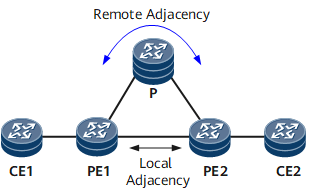Compatible Local and Remote LDP Session
Principles
The local and remote LDP adjacencies can be connected to the same peer so that the peer is maintained by both the local and remote LDP adjacencies.
On the network shown in Figure 1, when the local LDP adjacency is deleted due to a failure in the link to which the adjacency is connected, the peer's type may change without affecting its presence or status. (The peer type is determined by the adjacency type. The types of adjacencies can be local, remote, and coexistent local and remote.)
If the link becomes faulty or is recovering from a fault, the peer type may change while the type of the session associated with the peer changes. However, the session is not deleted and does not become Down. Instead, the session remains Up.
Usage Scenario
A coexistent local and remote LDP session typically applies to L2VPNs. On the network shown in Figure 1, L2VPN services are transmitted between PE1 and PE2. When the directly connected link between PE1 and PE2 recovers from a disconnection, the processing of a coexistent local and remote LDP session is as follows:
- MPLS LDP is enabled on the directly connected PE1 and PE2, and a local LDP session is set up between PE1 and PE2. PE1 and PE2 are configured as the remote peer of each other, and a remote LDP session is set up between PE1 and PE2. Local and remote adjacencies are then set up between PE1 and PE2. Since now, both local and remote LDP sessions exist between PE1 and PE2. L2VPN signaling messages are transmitted through the compatible local and remote LDP session.
- When the physical link between PE1 and PE2 becomes Down, the local LDP adjacency also goes Down. The route between PE1 and PE2 is still reachable through the P, which means that the remote LDP adjacency remains Up. The session changes to a remote session so that it can remain Up. The L2VPN does not detect the change in session status and does not delete the session. This prevents the L2VPN from having to disconnect and recover services, and shortens service interruption time.
- When the fault is rectified, the link between PE1 and PE2 as well as the local LDP adjacency can go Up again. The session changes to the compatible local and remote LDP session and remains Up. Again, the L2VPN will not detect the change in session status and does not delete the session. This reduces service interruption time.
